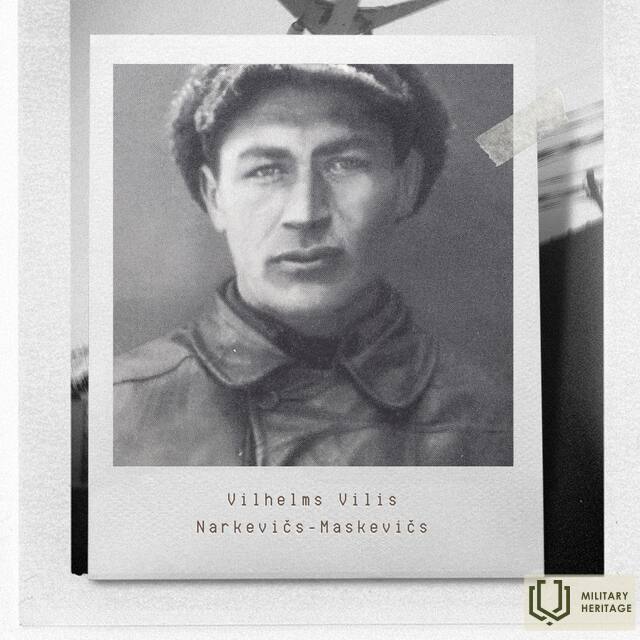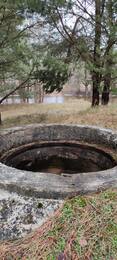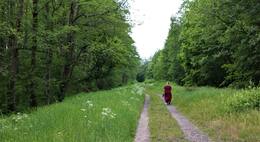Description of the combat activity of Vilis Narkevics on 6 November 1919
Description of the combat activity of the commander of the detachment, Lieutenant Commander Julius Rosenthal Vilis Narkevics, 3 November 1921
Description of the combat activity of the commander of the detachment, Lieutenant Commander Julius Rosenthal Vilis Narkevics, 3 November 1921
"On the night of 5/6 November 1919, the commander under my command took up position in the district of Šķede along the line of forts from the sea to the height of the rampart about ½ versti, with the task of holding the said line at all costs and reconnoitring the enemy along the seafront.
The platoon consisted of 23 soldiers with 50 cartridges per man, a rocket-pistol with 4 cartridges and an English rifle with a sufficient number of cartridges, commanded by Corporal, then Private Narkevics as an old rifleman with Christmas and January battle adventures. Except for the sergeant in charge, who fell, and Corporal Narkevics, none of the soldiers had taken part in the battles before.
After driving several parties of scouts from our fire, at about 0200 hours on 6 November 1919, the enemy attack began in large force. The action of 9 machine guns and cannon could be observed in the area of my platoon. The surrounding darkness prevented the enemy from taking the correct direction and most of the invaders, pushing off into the sea, concentrated against my convoy.
I signalled the English squadron with rockets to fire a square in front of the forts, but no fire was opened and the enemy had to proceed without artillery. The number of rifle cartridges was limited, they were running low and I received new ones only when the battle was over. The enemy had broken the front between my wire and that of my neighbours behind the elevation and advanced towards me under cover on the other side of the canal at a distance of about 100 yards, whence he opened a preparatory fire for a blow. It was impossible to reply satisfactorily, as the cartridges left only one magazine per man.
I assembled the others in the end of the rampart trench so that I could receive the enemy at the bayonets, and ordered Corporal Narkewitz and his detachment to creep along the seaward dunes towards the Schiede and open fire with the cannon on the enemy's wing and rear. This was the only means of at least preventing the enemy from taking the rampart of the fort in a few minutes, as only a small part of the front line could be crossed with bayonets.
Thanks to his agility and the darkness, Corporal Narkewitz succeeded. The other soldiers carried the rifle cartridges and guarded the rifle. Narkevics mounted the cannon on a seaside dune and opened heavy fire on the enemy. At that moment, according to later information gathered from the whipping-boy Ebel, who was to be executed on the sentence of the Court Martial for high treason, two companies of Russian cavalry arrived in column without horses and came close to the rifle, which was fired back in disorder. Thinking to flank and be repulsed from the rear, those in front of us threw themselves on the seafront side of the Skede road, leaving 2 heavy and 4 light machine guns, many hand grenades with which the whole company was armed, rifles, cartridges, bomber shells, 9 dead and more wounded. We captured 5 German soldiers and one Latvian in the area of the vada.
To Corporal Narkevics' shrewdness, agility and cold-bloodedness must be given the credit that the line of forts was not captured that very night from the enemy. Narkevics returned with an undamaged German heavy machine-gun and 7 boxes of cartridges."
3 November 1921
3rd Company Commander
Lieutenant Julius Rosenthal.
Related timeline
Related topics
Related objects
Corporal Narkēvic's trench
The excavation restored by Corporal Narkēvics is located in the immediate vicinity of the Cietokšņa Channel and can be viewed both separately and along the Karosta Freedom Trail.
The site of the trench from which Latvian Army Corporal Vilis Narkēvics guarded the Šķēde Bridge using a rifle (light machine gun). Corporal Narkēvičs was armed with a 7.69 mm calibre Lewis assault rifle (light or hand machine gun) purchased from the British. With 97 rounds loaded in the magazine, it was a heavy (almost 12 kg) but effective weapon. Corporal Vilis Narkēvics' experience gained on the World War fronts and his accurate machine-gun fire won the battle. He was awarded the Military Order of the Order of the Knights of the Latvian Armed Forces.
NBS soldiers and servicemen restored Corporal Narkēvics' position in April 2017.
Freedom Trail (Karosta route)
A well-maintained, 9 km long walking trail created to commemorate the bravery and heroism of Latvian men during the Latvian Freedom Struggle in 1919.
The trail starts in Redana and runs through the forest area of Karosta, along the seashore and the Cietokšņa Canal, including a visit to the Tsarist-era fortifications and Soviet-era military heritage. The trail features 5 information boards, which introduce the creation of the Karosta and the fortification system that encircles the entire city, the 1919 Battle of Freedom in Liepāja, the military structures built in later years and life in the Karosta during the Soviet era.
On 18 November 1918, the independent Republic of Latvia was proclaimed, but several foreign troops were still stationed on the territory of the newly established Latvian state.
The Battle of Liepaja in November 1919 played an important role in Latvia's regaining its freedom, when, thanks to the heroism of the soldiers, the enemy was outnumbered almost 5 times. After the decisive battles in Liepaja, Bermont was driven out of Latvia
Monument to the soldiers who fell in the battles for the liberation of Liepāja at the Northern Cemetery
The main memorial site of the War of Independence in Liepāja is located at the Northern Cemetery, where a monument designed by K. Bikše - Pikše to those who fell in the liberation battles near Liepāja was unveiled on November 24, 1924. The monument was damaged during World War II, but was restored in 1989.







